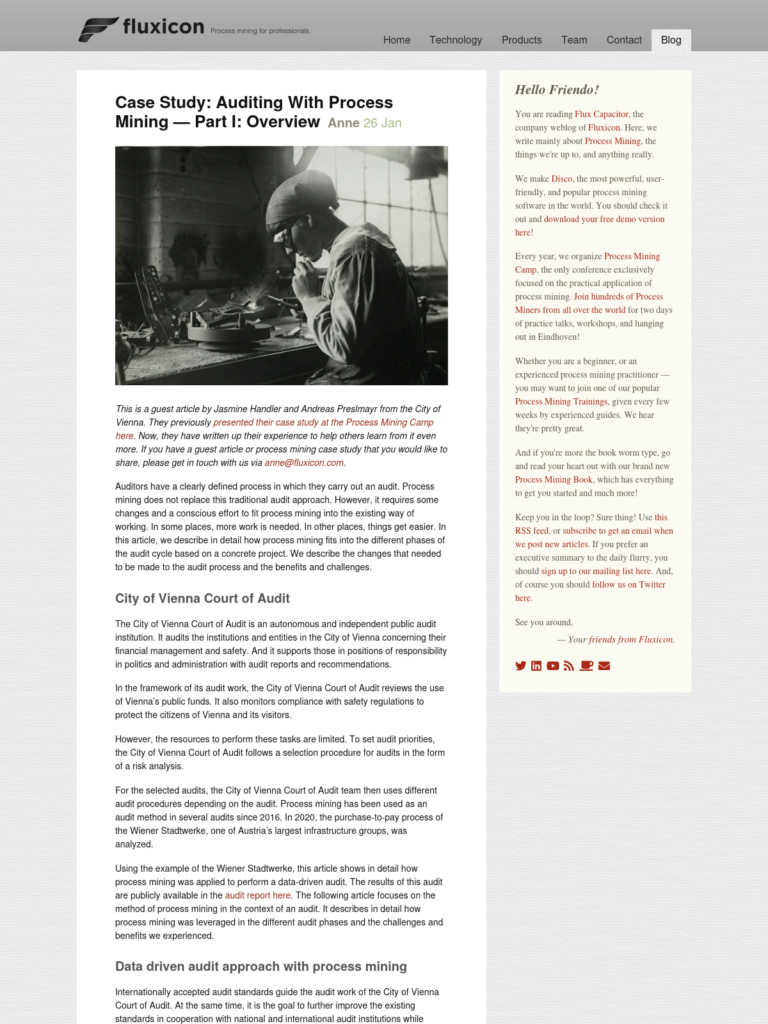Case Study: Auditing With Process Mining — Part I: Overview

This is a guest article by Jasmine Handler and Andreas Preslmayr from the City of Vienna. They previously presented their case study at the Process Mining Camp here. Now, they have written up their experience to help others learn from it even more. If you have a guest article or process mining case study that you would like to share, please get in touch with us via anne@fluxicon.com.
Auditors have a clearly defined process in which they carry out an audit. Process mining does not replace this traditional audit approach. However, it requires some changes and a conscious effort to fit process mining into the existing way of working. In some places, more work is needed. In other places, things get easier. In this article, we describe in detail how process mining fits into the different phases of the audit cycle based on a concrete project. We describe the changes that needed to be made to the audit process and the benefits and challenges.
City of Vienna Court of Audit
The City of Vienna Court of Audit is an autonomous and independent public audit institution. It audits the institutions and entities in the City of Vienna concerning their financial management and safety. And it supports those in positions of responsibility in politics and administration with audit reports and recommendations.
In the framework of its audit work, the City of Vienna Court of Audit reviews the use of Vienna’s public funds. It also monitors compliance with safety regulations to protect the citizens of Vienna and its visitors.
However, the resources to perform these tasks are limited. To set audit priorities, the City of Vienna Court of Audit follows a selection procedure for audits in the form of a risk analysis.
For the selected audits, the City of Vienna Court of Audit team then uses different audit procedures depending on the audit. Process mining has been used as an audit method in several audits since 2016. In 2020, the purchase-to-pay process of the Wiener Stadtwerke, one of Austria’s largest infrastructure groups, was analyzed.
Using the example of the Wiener Stadtwerke, this article shows in detail how process mining was applied to perform a data-driven audit. The results of this audit are publicly available in the audit report here. The following article focuses on the method of process mining in the context of an audit. It describes in detail how process mining was leveraged in the different audit phases and the challenges and benefits we experienced.
Data driven audit approach with process mining
Internationally accepted audit standards guide the audit work of the City of Vienna Court of Audit. At the same time, it is the goal to further improve the existing standards in cooperation with national and international audit institutions while engaging in the exchange of experiences. Audits are carried out according to the standardized audit process (see Figure 1).

Figure 1: Overall audit process
Each step of the process depicted above contains several tasks. Figure 2 shows the tasks related to the step ‘Conducting the audit’: First, an audit concept is created. Then, the data is collected. This data is then used to perform a situational and deviation analysis, from which the audit results and recommendations are derived. In addition, the audit trail and evidence are documented, and the audit file is generated.

Figure 2: Conducting the audit
We must adapt our working method when we use process mining in our general audit approach. Especially the way of collecting and analyzing data changes within the audit process compared to other audit methods.
To include process mining into the ’Collection of data’ and ‘Situational and deviation analysis’ phases, we followed the nine steps shown in Figure 3.

Figure 3: Data driven audit approach with process mining
Following this model helped us a lot to standardize our approach when using process mining in an audit. It summarizes the essential deliverables for collecting the data and performing the situational and deviation analysis. In the following sections, we explain each step and each deliverable of the model depicted in Figure 3 in more detail.
- Step 1 – Data analysis concept (next week)
- Step 2 – Analysis questions (coming soon)
- Step 3 – Process and data model (coming soon)
- Step 4 – Raw data (coming soon)
- Step 5 – Data transformation (coming soon)
- Step 6 – Data sets (coming soon)
- Step 7 – Discovered model (coming soon)
- Step 8 – Analysis answers (coming soon)
- Step 9 – Data analysis results (coming soon)
- Challenges and benefits (coming soon)
New parts in this series will appear on this blog every week. Simply come back or sign up to be notified about new blog entries here.
And if you don’t want to wait, you can sign up for our café mailing list or the process mining news until Monday 30 January 2023. There, you will receive a PDF version of the full article already next week. Stay tuned!
Leave a Comment
You must be logged in to post a comment.








